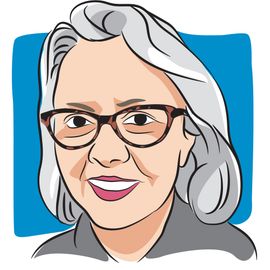- About Us
- Advertise / Support
- Editorial Board
- Contact Us
- CancerNetwork.com
- TargetedOnc.com
- OncLive.com
- OncNursingNews.com
- Terms & Conditions
- Privacy
- Do Not Sell My Information
- Washington My Health My Data
© 2025 MJH Life Sciences™ and CURE - Oncology & Cancer News for Patients & Caregivers. All rights reserved.
Hiking Through Breast Cancer Treatment

Felicia Mitchell, retired from college teaching, is a poet and writer who makes her home in southwestern Virginia. She is a survivor of stage 2b HER2-positive breast cancer diagnosed in 2010. Website: www.feliciamitchell.net
Hiking helped to sustain me through cancer treatment, with its emphasis on fresh air, natural wonders, and the companionship of friends.
When I was undergoing treatment for breast cancer, hiking helped me. A month after my mastectomy, for example, I climbed Mt. Rogers, the highest mountain in Virginia, with a group of friends. I keep a photo of us in that autumn splendor on the mantel.
The hike to Mt. Rogers was feasible as I had begun hiking in earnest, solo and with friends, when I became my mother’s caregiver. Having time to myself helped me to juggle multiple roles. Just as much of my social life began to center around hiking, my interior life needed the trails for contemplative times in a natural setting.
After starting chemo, though, I knew I would have less energy to climb mountains. I made do with shorter hikes and casual walks. I also promised I would not walk alone and honored that promise until I finished the first phase of treatment. Since side effects of chemo included some neuropathy, fatigue and a crooked stride just after an infusion, walking through months of treatment took some getting used to mentally. Still, I continued to get outside as best I could.
My continued association with the natural world was bolstered by reassurance early on from my chemo oncologist. One of my favorite entries in my cancer journal not long after starting chemo says, “Met with Dr. D.: hiking is good. Blood work & kidney function good.” The journal otherwise contains meticulous notes about meetings with doctors, visits to the infusion center, or radiation. I wrote down advice such as “eat some red meat” or “let us know if you can’t get out of bed.” “Hiking is good” was in good company.
On the same day I wrote “hiking is good” in the cancer journal, I wrote this in my nightly journal: “Big chemo. Sort of wiped me out, but did go to Osaka’s with Guy [my son] and eat veg. sushi rolls and made baked chicken for supper. We had fun laughing. I was punchy and giggling again.” I could not walk in a straight line after chemo that day. The contrast between how I walked just sometimes and how I walked when I had enough energy to get out for a hike was dramatic. I needed that contrast to remind myself what I had in me.
In that nightly journal, where I continued to talk about hikes, I mention birds, including a beautiful hawk on a post. I describe a special afternoon at Fairy Stone State Park in Virginia. Comments on wildflowers and the camaraderie of the trail appear now and then. It was not always easy, but it was always beautiful, as I note in this entry: “Long walk off Blue Ridge Parkway. Not a lot of energy.” Energy waxed and waned. I especially love this entry about a good day: “Six-mile hike on AT — Bunny’s birthday! Made cardamom cake with rose petal buttercream frosting.”
I will be honest that I was emotionally and physically worn out at the end of treatment, a time when I was too often in tears. Just two days after I felt I had, according to my journal, “hit the bottom,” I tried a hike to cheer myself up. “Drove to Boone to Turchin Gallery and to hike but got tired and came home.” Fortunately, after the bottom fell out that week, I rallied with the help of friends, my son, and the great outdoors. My notes remind me: “Hiked at Backbone Rock while Guy ran — saw a Great Blue Heron on the way out.”
For some of us, there is nothing like being outdoors, infused by nature, while healing from cancer or the weight of the world. Hiking sustained me during 14 months of cancer treatment and continues to keep me happy.
This piece reflects the author’s personal experience and perspective. For medical advice, please consult your health care provider.
For more news on cancer updates, research and education, don’t forget to subscribe to CURE®’s newsletters here.
Related Content:



